Linear Tube Audio MicroZOTL Preamp Level 2
Blurring the Lines
Over the last few decades, the gap between tube and solid-state sound has been closing, with both design camps trying to maintain their best attributes while incorporating some of the finest qualities of the other. Solid-state designers try to achieve the organic midrange quality and dynamic life of tube gear. In contrast, tube designers aim for the bass extension/definition, lower noise, and high-frequency extension of solid-state designs.
There are varying opinions among audio enthusiasts regarding the sound of amplifiers. Those who prefer transistors often highlight the technical specifications of their amplifiers and argue that tubes add too much color and that their zero-distortion amplifier is the perfect reference. In contrast, tube fans argue that transistors produce an unnatural and unmusical sound.
Let's be honest: the sound we hear in real life gets lost as soon as it is converted into electrical signals by microphones and further distorted during mixing, recording, storage, and playback.
As my audio journey continues, I remain agnostic about this subject.
What I do know is that when the musical stars align in my listening room, I have been moved to tears by both designs.
Just saying….
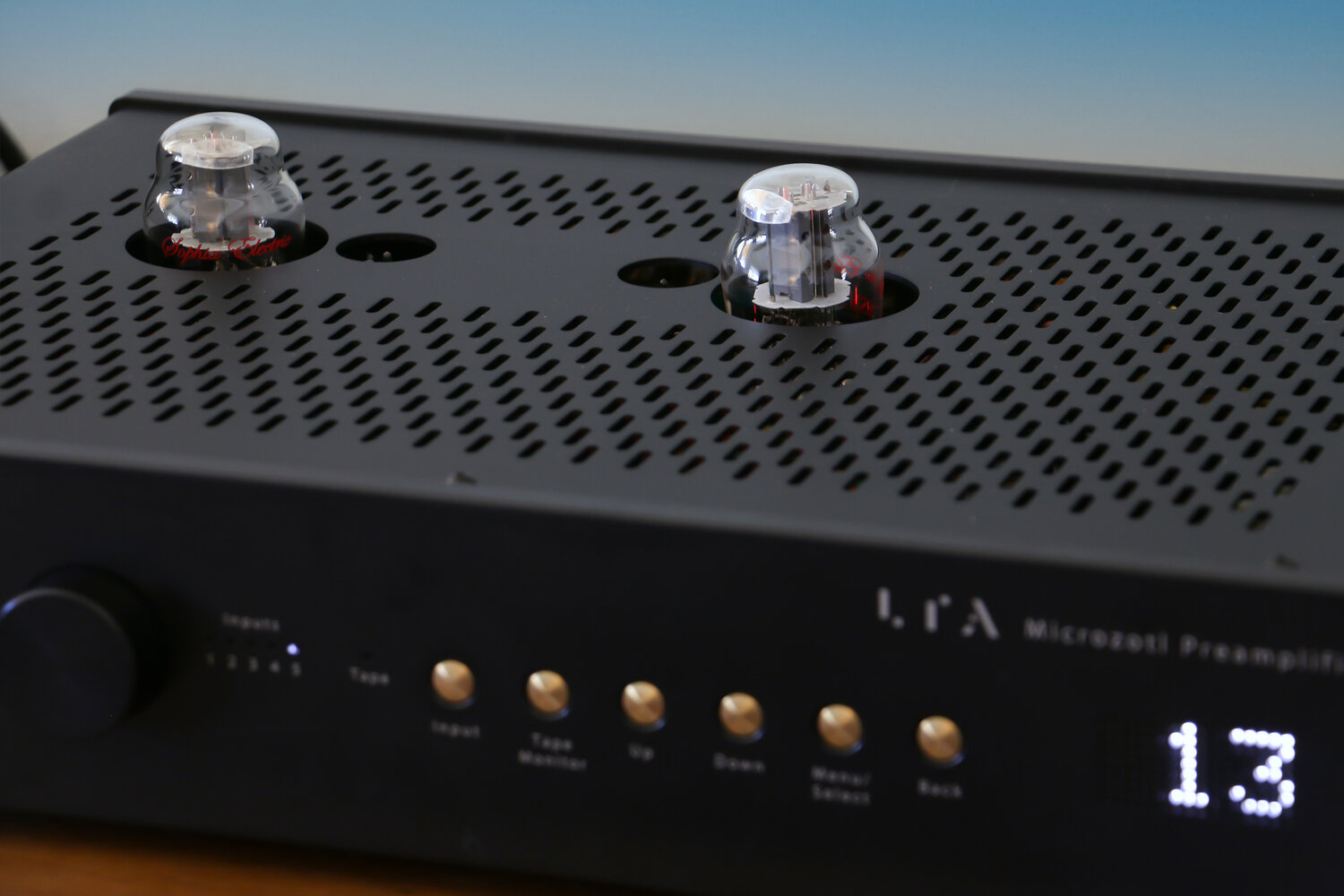 Enter David Berning
Enter David Berning
David Berning, a renowned amplifier designer with a formal education in physics, offers a unique perspective on designing solutions for classic audio problems. David had been developing and manufacturing tube amplifiers for over 20 years when, in 1996, he introduced his patented ZOTL (Zero hysteresis Output Transformer-Less) architecture, which is considered by many to be one of the more significant improvements to tube amplifier design since the early 1960s.
With his ZOTL design, he sought to remove what he believed to be one of the primary sources of coloration in tube amplification, the output transformer. Long known to designers, leakage inductance and interwinding capacitance limit the high-frequency response of transformers, while core saturation and magnetizing current limit their low-frequency response.
David summarized his thoughts in a paper many years ago. In this excerpt, he touches on why tube products may be more comfortable to listen to, which I found interesting.
"I can say that audio transformers do influence the sound of amplifiers by acting as frequency-dependent filters, and iron has rather severe hysteresis-induced nonlinearities that show up mainly at low frequencies where flux swings are large. As bad as this seems to look from a technical standpoint, when these distortions are added to those already present on the recording, the net result may not be bad because subjectively some of these effects can partially cancel. This does not mean that you are recovering any of the original musical information; you are at best making one mess more palatable. It may, however, still be easier to hear certain musical information if high-frequency hash is filtered."
For the technically curious, information regarding David's ZOTL design is available on these links: Linear Tube Audio or David Berning.
The Berning ZOTL circuit design is said to have several benefits, including:
•Improved tube life due to lower current operation
•No output transformer intermodulation distortion
•No low-frequency non-linearity
•Distortion by parasitic transformer elements of the audio signal no longer occurs
•Improved bass due to flat, linear bass response to below 10hz
•Removal of low-frequency limit for bass response
While initially used in amplifiers, when David applied his ZOTL circuity to a preamp, he found it would provide a robust output drive with a very low output impedance of 50 ohms without feedback. He described the result as allowing him to:
"… extend the desirable musical transparency of tubes to the frequency extremes and provides the quickness of the high and low frequencies that are cherished by those who prefer solid-state amplifiers."
Unfortunately, since the debut of David's ZOTL technology, no one has been able to commercially manufacture David Berning's complex designs.
Until….
Enter Linear Tube Audio
Mark Schneider, an experienced electrical engineer who has worked in management, manufacturing, and product design and is the architect of the world's fastest document scanner, founded Linear Tube Audio in 2015 to pursue his passion for High-End Audio. Producing Berning circuits is a complicated and demanding task, which makes manufacturing them efficiently both challenging and costly. Despite this, Mark was drawn to the intricate and unique ZOTL circuits and their sound quality, and his background enabled him to take on the manufacturing challenge and introduce David's designs to a broader market.
David and Mark collaborated on the MicroZOTL preamp, with David focused on the amplifier circuit design and Mark contributing the software control, volume system, linear power supply, and component selection and upgrades. Their partnership was a perfect match of skills and expertise.
Each MicroZOTL Preamp is hand-built by Linear Tube Audio in Takoma Park, Maryland, with over 12 hours of delicate work, including precise hand-winding of several proprietary components and several days of burn-in and testing before shipping.
First launched by LTA in 2016, the MicroZOTL preamp is the 4th generation refinement of the original half-chassis MicroZOTL 2.0 preamp. After a thorough evaluation project by David and Mark that spanned three years, the $4450.00 preamp underwent a production change in 2020, including the following upgrades without a price increase. Nice!
Power transformer upgrade: The power transformer is upgraded to a larger custom transformer with multiple windings to improve isolation, which results in lower noise.
Coupling cap upgrade: The six coupling caps on the audio board between the tube stages are upgraded to premium Japanese film caps with gold-plated OCC leads.
Updated volume control w/ gain adjustment and "Hi-Res" setting: The new 8-bit volume control gives 128dB of total attenuation via 100 individual steps. "Hi-Res" increases this to 199 steps for finer level control. In addition, three gain control options are available: 0dB (default), -15dB, and -30 db. This adjusts the volume level to allow for finer low-level attenuation when using sensitive speakers or headphones.
The new Level 2 upgrade, the subject of this review, brings the preamp’s cost to $5450.00 and includes:
Preamp output cap upgrade: The headphone and the preamp outputs have been separated, and different types of output caps, optimized for each output, are installed. The preamp cap is upgraded to a premium Clarity CMR.
Power supply cap upgrade: The power supply caps and power storage caps on the audio board are changed to Mundorf Mlytic AG capacitors. The total amount of storage is increased by 22,000uF.
For an additional $300.00, you can upgrade to a balanced input with high-quality Lundahl input transformers on the XLR inputs. This upgrade is recommended if you use a balanced source component. I commend LTA for its excellent upgrade program, which allows previous product owners to update to the current version of their choice at fair prices, protecting their investment. Thank you!
Designed and crafted by Fern & Roby, the black aluminum chassis highlighted with brass buttons measures 17" W x 12.4" D x 4.2" H and weighs 14 lbs. The flawless fit and finish exudes a sense of solidity. While beauty lies in the eye of the beholder, I am drawn towards a clean, classic, and functional appearance coupled with a sturdy feel.
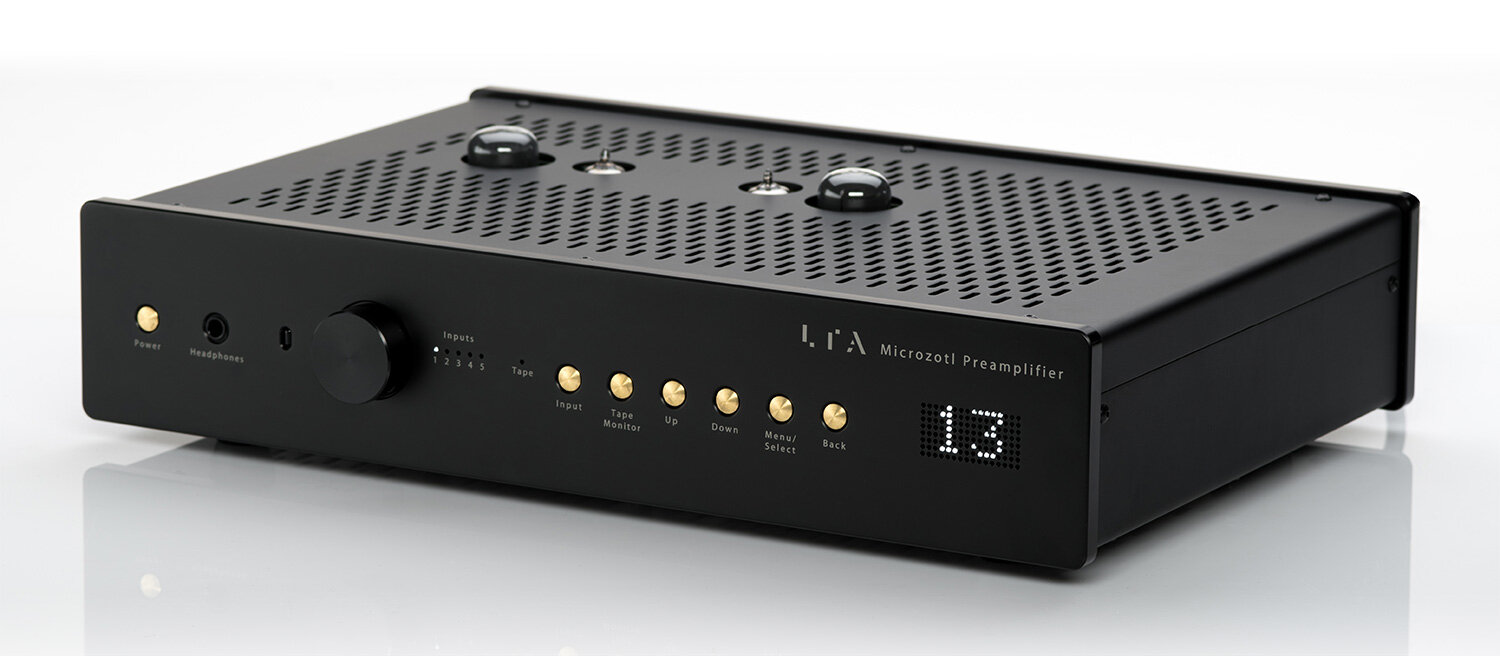 Starting on the left, we find the power button, two headphone jacks, volume control, and the input LED indicators. Continuing with a row of brass buttons for input selection, manual volume up/down, or menu select functions. Lastly is an LED array display with sixteen brightness levels and an option for a seven-second "timeout" to go dark after you set the volume, a feature that I like on a preamp.
Starting on the left, we find the power button, two headphone jacks, volume control, and the input LED indicators. Continuing with a row of brass buttons for input selection, manual volume up/down, or menu select functions. Lastly is an LED array display with sixteen brightness levels and an option for a seven-second "timeout" to go dark after you set the volume, a feature that I like on a preamp.
The all-analog audio signal pathway uses a rotary encoder with software-controlled relays to switch a resistor ladder for volume and balance.
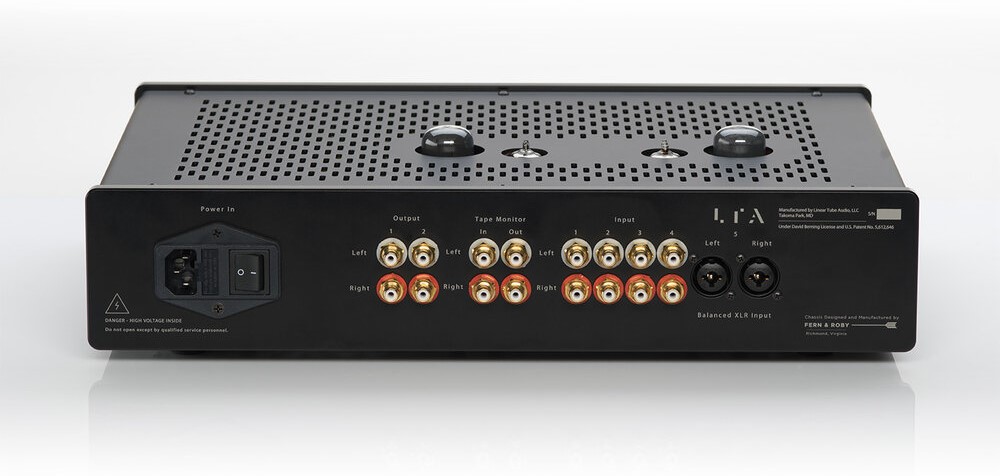 A quick tour of the rear reveals four single-ended RCA inputs using Cardas connectors and one XLR input using Neutrik connectors. Tape in/out RCA jacks and two pairs of single-ended RCA outputs.
A quick tour of the rear reveals four single-ended RCA inputs using Cardas connectors and one XLR input using Neutrik connectors. Tape in/out RCA jacks and two pairs of single-ended RCA outputs.
The unit comes with two NOS 12SN7s and two 12AT7s, which provide very good sound. If you have a collection of 6SN7s, you can easily swap them out with the flick of an internal switch and take a trip on the tube rolling train. While I have an unfortunate number of ticket stubs from rides on that train, I stayed with the stock tubes throughout my 10-week audition.
During my conversation about tube rolling, Nicholas Tolson, LTA's national sales manager, recommended that the tubes be gain-matched/balanced for optimal performance. He also mentioned that LTA provides replacement tubes for all their products and only sells tubes to LTA customers, which come with a one-year warranty.
When viewed from above, the layout appears well-organized. You see the linear power supply on the right side with a dual secondary transformer and a large heat sink for the choke-isolated Belleson super-regulator. The large red Clarity CMR output capacitors are on the left side, while silver Lundahl transformers and white volume control relays are on the rear board.
The center yellow ceramic circuit board contains the ZOTL circuitry with a black switch in the middle that enables using either 6SN7 or 12SN7 tubes. Instead of using a typical FR4 PCB laminate circuit board, LTA has opted for a higher-quality ceramic board with less parasitic capacitance and a lower dielectric constant, making it more expensive but offering improved performance in the areas of transparency and presence. All the board traces are made of 2 oz. copper, the circuit does not use global feedback, and the unit is packed with top-notch components you often don't see at this price point.
Current production units now come standard with a sleek metal LTA remote that comfortably fits in your hand and gives you complete control over virtually all preamp functions.
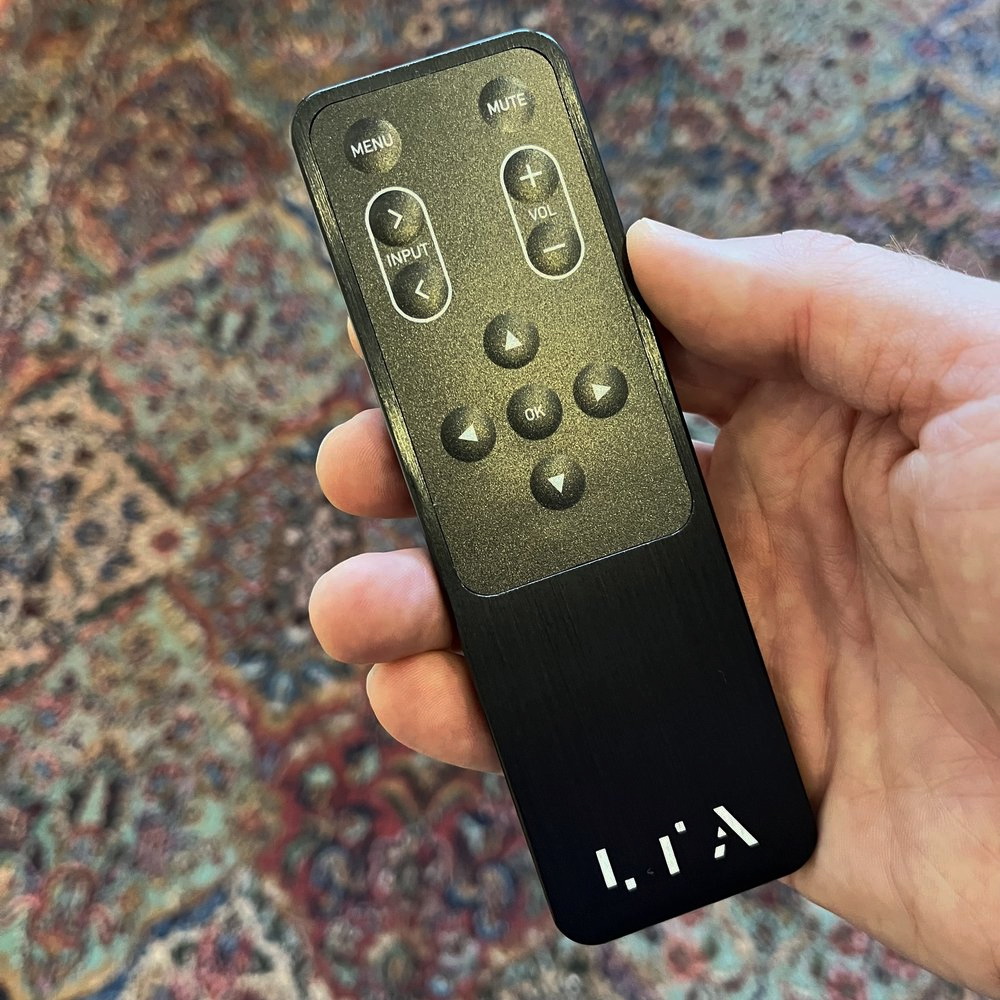 Owners of the previous models shown below can upgrade to the new LTA-branded remote, but the unit will be returned to the factory to reprogram the unit's software. Check the LTA website for the details on their upgrade program offerings.
Owners of the previous models shown below can upgrade to the new LTA-branded remote, but the unit will be returned to the factory to reprogram the unit's software. Check the LTA website for the details on their upgrade program offerings.
•MZ3
•MicroZOTL Preamplifier - Level 1 / Level 2 ( with apple remote)
•Z10 Integrated
•Z10e
•Ultralinear / Ultralinear+ Integrated
•Z40 / Z40+ Integrated
I am not a headphone guy, but Nicholas informed me that they devoted significant attention and resources to the headphone amp section of the MicroZOTL preamp. Unlike many preamps where the headphone output is but an afterthought addition, the headphone output on this preamp fully utilizes the preamp's unique circuitry, as seen in the block diagram below.
 The Hookup
The Hookup
The LTA MicroZOTL preamp replaced my reference SMc Audio VRE-1c preamp that drives an SMc GT 23 Ultra amp hooked up to Acora SRC-2 speakers with a REL S/812 six-pack (review coming).
I used a Jay's Audio CDT 3 MKIII CD transport and my Innuos Zenith MKIII/Phoenix USB connected to a PS Audio DACII for CDs and streaming. Signal cabling was Audience Front Row, Iconoclast, and power cabling was Kubala Sosna Elation! and Genesis Advanced Technology. I spun vinyl on my AMG Viella V12JT/ Benz LP-S combo into a Tom Evans Groove Plus SRX MK 2.5 phono stage.
Listening
After owning the Berning TF-10 and TF-12 preamps in the past, it was quickly apparent that the LTA preamp has taken that pedigree of sound to new heights. The MicroZOTL preamp has outstanding clarity and exhibits excellent inner resolution. It can reveal the tone and timbre of instruments and voices, and the deep, tuneful bass is impressive. The preamp's ability to deliver exceptional speed, clarity, and dynamic expression in the upper-midrange region creates a sense of aliveness. It's not that this area is excessively emphasized or bright but rather that it feels open and dynamically unbridled. It has a detailed yet delicate treble and produces the airy images and sound staging you expect from a top-quality component. All these attributes combine to create a musical and engaging preamp.
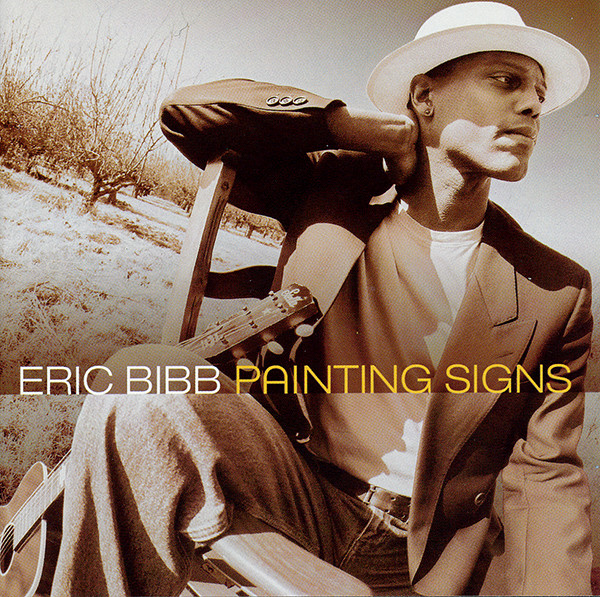 I heard the Angels Singing
I heard the Angels Singing
From the opening guitar notes and Eric Bibb's vocals, you know you're in for something special with this preamp. It sounds effortless and unencumbered, and it doesn't feel like making music is an effort. It's very light on its feet yet has a density that makes the music dance. The song conveys Eric's emotional expressiveness with impressive dynamic expression and presence. Throughout the song, the piano, drums, and bass maintain their individuality and remain well-balanced with the music. In some tube preamps, the bass line in the song can sound somewhat "bloated" with little detail, which can detract from the song's quality. However, this is not the case with the MicroZOTL preamp, as the bass stays in its lane, and you can hear the detail captured in it.
 The Wish (Live at the Walter Kerr Theatre )
The Wish (Live at the Walter Kerr Theatre )
From the beginning, the piano's decay and Springsteen's voice create an immersive auditory experience, just like you were in the theater. Bruce's voice is captured, revealing his raspy, nasal tone. The piano is beautifully recorded, with the dynamics and weight you would expect to hear were you standing by it, along with the overtones being transparently resolved and "hung in the air." There is a very quiet segment in the middle of the song where you get a "sense of space," and you feel like you are part of the audience, respectfully keeping quiet. The song's ending applause is well-balanced and realistic, thanks to the MicroZOTL preamp's ability to resolve micro details and create an involving soundstage.
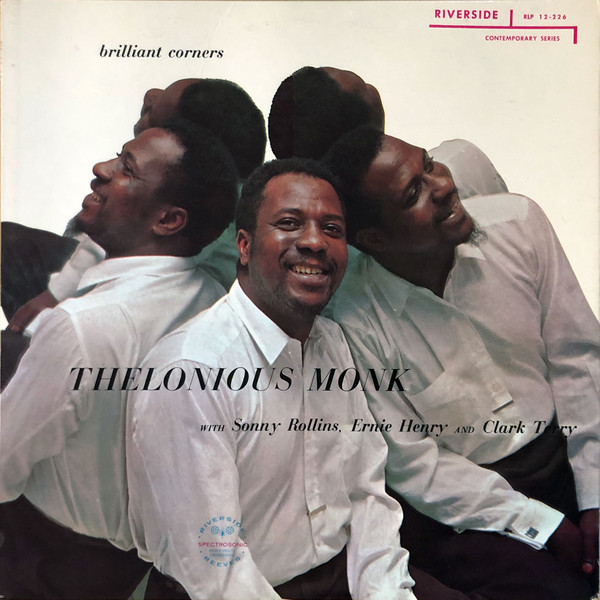 Ba-Lue Bolivar Ba- Lues-Are
Ba-Lue Bolivar Ba- Lues-Are
I frequently use this song because it incorporates a wide range of instruments, and I love the artistry of the musicians. The opening piano notes Thelonious Monk plays are impressive and immediately grab your attention. The combination of Sonny Rollins and Ernie Henry's tenor and alto saxophones creates a unique sound that the LTA preamp quickly resolves, allowing you to appreciate the individual contributions of each instrument. Oscar Pettiford's double bass solo is rendered with great emotion without sounding overdone or a bit "bloated," as I have heard on some tube preamps.
Max Roach's drumming is truly exceptional. Throughout the song, you can easily hear the distinct tone of each drum and the varied dynamic expressions he expertly weaves into his playing while "working" the drum kit. The MicroZOTL preamp easily passed this test with flying colors.
Conclusion
Compared to many solid-state preamps that produce a dry, thin sound, the tube-based MicroZOTL preamp adds a touch of instrument density and richness while delivering speed, clarity, and accurate bass that solid-state advocates enjoy. It creates a seamless, immersive, and layered soundstage that results in an engaging listening experience. The preamp's midrange is fast-paced, filled with dynamic energy, and offers a rich sound without the overlay of a warm, comfortable light many tube preamps bathe the music in. It never felt strained or confused by anything I threw at it and consistently maintained its composure.
If concealed behind a curtain, and experienced listeners were asked to identify whether it was a tube or solid-state unit, most would consider it a solid-state unit because of its speed, transparency, and excellent bass definition. Nevertheless, they would still appreciate its tonal quality, dynamic expression, and subtle tube-like characteristics.
Taking up residence on the fence between tube and solid state, the preamp presents the musical message in a direct and unfiltered manner that belies the four tubes that protrude from the cover.
It does indeed "blur the lines" between the two types of amplifying devices.
In closing, I am reminded of one of my favorite quotes.
"If I had asked people what they wanted, they would have said faster horses." Henry Ford
Sometimes, it can be more effective to approach a problem with a fresh perspective rather than continually improving on existing ideas. The MicroZOTL preamp provides an option for audiophiles devoted to either tube or solid-state technology but who desire to enhance their listening experience with a quality offered by the other.
I will simply say….
If you are considering a preamp for less than ten grand, solid state or tube, giving the MicroZOTL preamp Level 2 a fair listen would be in your best interest.
Enthusiatically recommended
Specifications
Price as reviewed: $5750.00
Inputs: 4 Stereo RCA single-ended inputs using high-quality Cardas connectors; 1 XLR single-ended input, with transformer-coupled balanced option with Lundahl transformers. Sealed, silver contact relays utilized in a short signal path—one additional Tape input.
Outputs: Headphone ¼" Phone jack, dual Cardas RCA single-ended preamplifier outputs, and a Tape Monitor output utilizing Cardas RCAs (input level before volume control).
Amplifier class: Push-pull Class A, no feedback
Sensitivity: 0.6V RMS [full output]
Output impedance: (measured @ 0.5A, 60 Hz) 2 ohms for headphone outputs, 50 ohms for preamplifier outputs.
Input impedance: 50k
Volume Control: Stepped attenuator constructed of 1025 steps of 50 ohms, with 100 positions selected to provide very fine resolution at the lowest volumes and a logarithmic control for higher volumes. Low noise, precision 1% Vishay Dale resistors, and hermetically sealed silver contact relays are used for precise, isolated analog signal attenuation.
Balance Control: 100% channel isolation using stored differences of volume values. The maximum balance differential is 16 steps.
Power Supply: Linear power supply available in 110/120 and 220/240 (100V linear supply available for Japan). Uses dual banks of organic poly ultra-low ESR capacitors (4 times MZ2) and premium Nichicon electrolytic for over 100Kuf of output choke isolated storage. Oversize transformer secured with aluminum and brass mountings (no steel). Regulation is performed using low-noise Belleson super regulators. The current transformer controls the output protection circuit.
Hum and noise: minimum 60mV RMS or 90dB below full output (20Hz-20kHz)
Power consumption from ac power source: approx. 50W
Power output: with 4-ohm load: 1W, 1% THD, with 14-ohm load: 0.5W, 1% THD
Channel separation: (4-ohm loads) 46dB, 100Hz-10kHz, (14-ohm loads): 54 dB, 100Hz-10kHz
Frequency response full power: (4-ohm load) +0, -1dB 10Hz-20kHz, (14-ohm load): +0, -1dB 5Hz-50kHz,
Voltage gain: (4-ohm load): 10.3dB, (14-ohm load): 12.4dB
Front Panel Control: Functions include volume, input selection, headphone/speaker output selection, all configuration menu selections, and amplifier power on-off. Capacitive brass touch buttons are utilized for menu control, input selection, tape monitor control, and power on-off.
Remote Control: All functions, including Mute and the configuration menu, are available from the remote, except power on-off.
Auto-save Features: Volume level per input is automatically saved, and the unit powers on using the stored volume levels. Balance and all other configuration menu selections are all saved as a global level across all inputs.
Display Controls: 16 levels of brightness and on-off selectable 7-second timeout
Home Theater Mode: an input can be selected from the configuration menu to set one of the inputs to a high-volume level fixed input to allow the surround sound device to control the volume level.
Front Panel Power Switch Override: The power switch on the front panel can be configured to be set to always on to allow external on-off control for devices such as remote-controlled power conditioners.
Tube complement: 2 premium hand-selected 12AT7 input tubes and two premium hand-selected 12SN7 output tubes. (6SN7s can be used with jumper settings) 12AU7s are often substituted for the 12AT7s to lower the gain if higher headphone output is not required.
Size: 17 inches (43.2 cm) wide, 4.2 inches (10.7 cm) tall, 12.4 inches (31.5 cm) deep (including knob and connectors)
Net weight: 14 lbs. (6.35 kg.) Shipping weight: 22 lbs. (10 kg)
Manufacturer Information
Linear Tube Audio
7316 Carroll Ave.
Takoma Park, MD, 20912
301-448-1534
hifi@lineartubeaudio.com










































.png)








